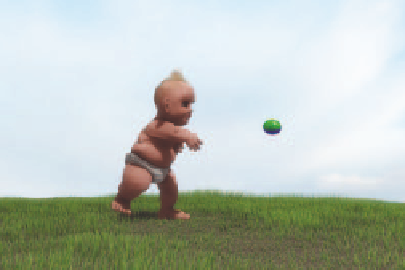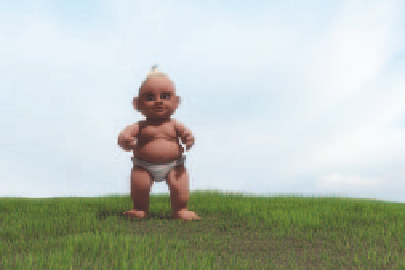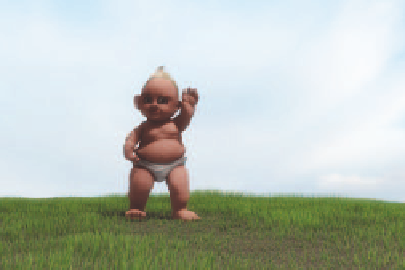Graphics Reference
In-Depth Information
Applying
squash
and
stretch
to the model of the ball can
do this. Figure 11.4 shows the fi nal frame again but with
the ball stretched slightly to show its motion.
Squash and stretch will apply to anything you are animat-
ing that moves at a high velocity or encounters some kind
of barrier. The degree to which it applies will depend on
the level of stylization of your project. Clearly, charac-
ters with a high degree of realism will neither squash nor
stretch much. It wouldn't be believable.
Overlap.
When living things move, their limbs, though
coordinated, do not move in perfect sync. During the
Beast's throwing motion, the leg begins to move before
the arms (Figure 11.5). Making sure that the motions of
a character occur in the proper sequence and not all at
once is called
overlap
.
Figure 11.4
I thought this thing was supposed to be rigid!
Symmetry.
A local journalist was watching the Beast
throw the ball and asked if he would pose for a picture
for the local paper. Figure 11.6 demonstrates
symmetry
.
Notice how much more natural he looks when things are
not symmetrical. Avoid creating symmetrical poses and
having otherwise symmetrical actions (e.g., both hands
reaching for a ball), begin and end on the same frame.
Figure 11.5
The leg has begun to move before the arm
holding the ball
Exaggeration.
The Beast has learned that through his
exposure in the local paper, a talent scout has discovered him, and he will soon be playing for the Pittsburgh
Toddlewackers. His triumphant pose in Figure 11.7 is
exaggerated
to convey his mood. A viewer should be
able to determine a character's mood, thoughts, and actions without any dialog. Too much exaggeration will
cause your animation to lose believability, but none at all will make it feel boring.
Figure 11.6
Avoid completely symmetrical poses




Search WWH ::

Custom Search